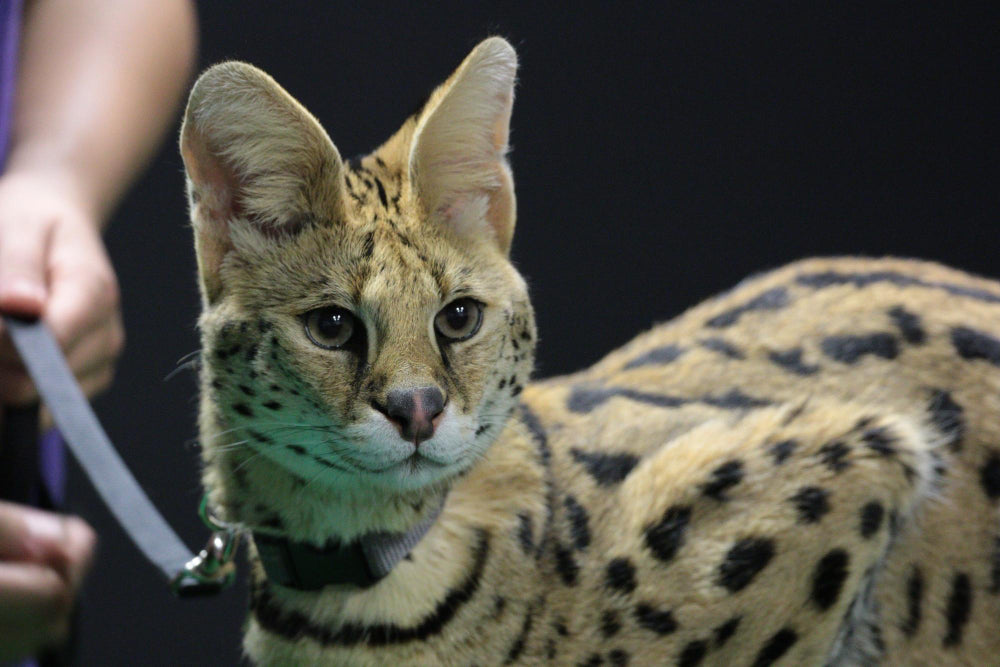The serval ( Leptailurus serval ) and the savannah cat are fascinating beasts that have captured the attention of exotic animal lovers. Although they may look similar at first glance, there are fundamental differences between the two categories. This article will provide a comprehensive overview of servals, their species, subspecies, the differences between them and savannah cats, and explain why it is better to choose a genuine serval than a hybrid savannah cat.
1. What is a serval?
The serval is a medium-sized wild cat native to Africa. It is known for its elegant appearance, slender build, long legs, and golden fur with black spots and stripes. In the wild, it lives in savannas, wetlands, and forest edges, where it hunts small prey such as rodents, birds, and fish.
• Size: 8–18 kg, body length up to 100 cm (excluding tail).
• Personality: Naturally wild, but socialized servals can be affectionate and form a strong bond with their owner.
• Lifespan: They live more than 20 years in captivity.
2. Serval species and subspecies
Although the serval is classified as a single species ( Leptailurus serval ), there are several subspecies that differ in appearance, size, and adaptations to specific environments. These differences have arisen through natural evolution in different geographical regions of Africa.
2.1 Leptailurus serval serval
• Distribution: Southern Africa (South Africa, Zimbabwe, Botswana).
• Characteristics:
• Typical golden fur with black spots.
• Medium size (8–14 kg).
• Interesting fact: The most commonly bred subspecies in captivity due to its adaptability.
2.2 Leptailurus serval lipostictus
• Distribution: West and Central Africa (Senegal, Cameroon, Congo).
• Characteristics:
• Darker coat and less contrasting black spots.
• Slightly smaller than the southern serval.
• Interesting fact: Adapted to denser forest areas, where it uses cover.
2.3 Leptailurus serval constantina
• Distribution: North Africa (Ethiopia, Sudan, Egypt).
• Characteristics:
• Lighter coat that blends better with the surrounding environment.
• The largest subspecies (up to 18 kg).
• Interesting fact: It prefers drier areas and open savannas.
2.4 Leptailurus serval brachyura
• Distribution: Islands off the east coast of Africa (Zanzibar, Comoros).
• Characteristics:
• Smaller body and shorter tail than other subspecies.
• Adapted to the limited environment of islands.
• Interesting fact: This subspecies specializes in hunting small reptiles and insects.
2.5 Melanistic serval
• Distribution: Kenya (highland areas).
• Characteristics:
• Black fur caused by a genetic mutation (melanism).
• At certain angles of light, subtle black spots are visible.
• Interesting fact: Very rare; black coloration reduces camouflage ability in the wild.
3. What is a savannah cat?
The savannah cat is a hybrid that was created by crossing a serval with a domestic cat. It was bred to create an animal that has the wild appearance of a serval but a temperament close to that of a domestic cat. These cats are referred to by generation: F1, F2, F3 , etc.
3.1 Generations of savannah cats
• F1: First generation (50% serval genes). Large, active and demanding to care for.
• F2: Second generation (25% serval genes). Still active, but a bit calmer than F1.
• F3 and beyond: Generations with a lower proportion of serval genes (12.5% or less). They resemble domestic cats more.
3.2 Savanah HP (High Percentage)
• What is it?
The HP savannah cat is an F1 hybrid with a very high proportion of serval genes (60–70%).
• Characteristics:
• Very similar to a serval in appearance and behavior.
• Larger size (10–15 kg).
• Higher demands on care and socialization than regular F1.
4. Why choose the original serval instead of the savannah cat?
4.1 Health complications of hybrids
• High mortality: Mating between a serval and a domestic cat is difficult and the young often do not survive.
• Genetic problems: Hybrids can suffer from birth defects and metabolic disorders.
• Low immunity: Hybrid cats are more susceptible to infections than purebred servals.
4.2 Ethical issues
• Mating Stress: The domestic cat is significantly smaller than the serval, making the mating process challenging and stressful.
• Commodification: Savannah cats, especially HPs, are becoming a fashion item, while servals are being bred with more respect for their natural needs.
4.3 Serval nature
The original serval retains its natural behavior, appearance, and instincts, making it an authentic animal for those who want to experience the true beauty of the African beast.
5. Comparison: Serval vs. Savanah HP and regular savannah cats
Breeding ethics
|
Factor |
Serval | Savanah HP (High Percentage) | savannah cat (F1-F3) |
| Genetics | 100% serval | 50–75% of serval genes | 50% or less of serval genes |
| Size | 12–18 kg | 8-15 kg | 6–12 kg |
| Behavior | Wild, independent | Active, partially wild | Calmer with each generation |
| Health risks | Very low | Higher risk of genetic defects | Medium to low |
|
Breeding ethics |
Natural breeding | Complicated mating | Often profit-oriented |
6. Conclusion: Why choose the original serval
The serval is an authentic beast that represents the beauty of nature in its purest form. Unlike hybrid savannah cats, whose breeding brings ethical and health concerns, breeding servals is more sustainable and less problematic. If you are looking for a fascinating exotic pet that is healthy, unique and fully respectful of nature, the original serval is the right choice.

